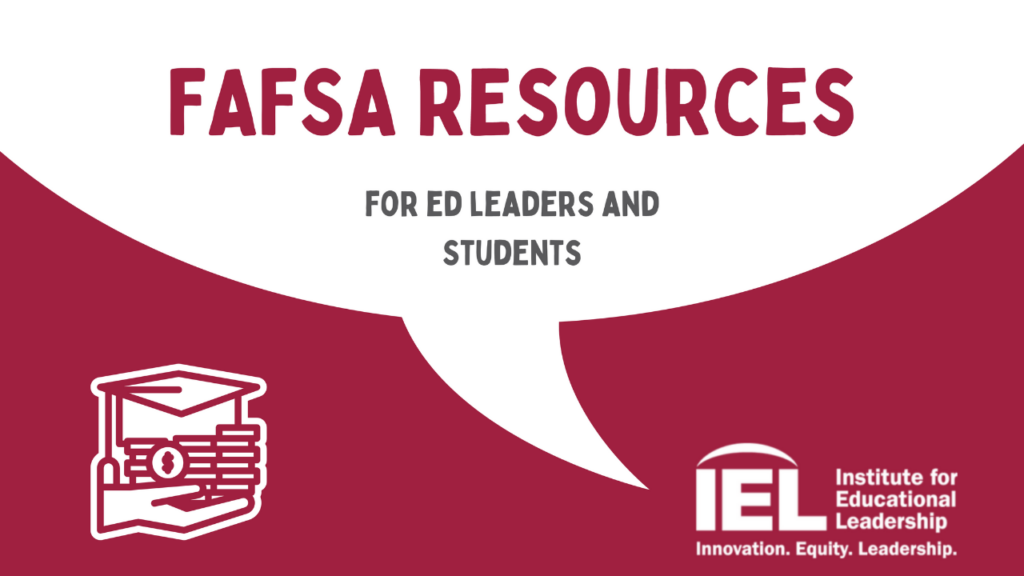The White House and the Department of Education hosted a National FAFSA Week of Action last week, April 15-19, 2024, and highlighted it’s new FAFSA website and financial aid application form for prospective college students. It’s crucial for students and educators alike to understand the significance of this system. Building off the FAFSA week of action’s goals to bolster awareness and support for the Free Application for Federal Student Aid (FAFSA®) form, known as the Better FAFSA, we’ve compiled some of the resources that were shared that can help streamline the college financial aid process and ensure more students have access to essential funding. Here is the key information and steps for both students and educators to maximize the benefits of FAFSA:
Why FAFSA Matters
The FAFSA form is the key to accessing financial aid for college. By completing the FAFSA, students can unlock up to $7,395 in federal aid that doesn’t need to be repaid. Plus, with the Better FAFSA, more students than ever before will qualify for Federal Pell Grants, making college dreams a reality for countless individuals.
What’s New in the 2024–25 FAFSA Form
The 2024–25 FAFSA form introduces significant changes aimed at expanding eligibility for federal student aid and enhancing the user experience. Here are the key updates:
- Expanded Pell Grant eligibility: The updated student aid calculations expand eligibility for Federal Pell Grants, benefiting an estimated 7.3 million students from low-income backgrounds. These changes aim to ensure that more students have access to crucial financial assistance for their higher education journey.
- Streamlined user experience: Applicants will experience a more streamlined process, with the option to skip up to 26 questions based on their individual circumstances. Depending on their situation, some applicants may only need to answer as few as 18 questions, significantly reducing the time required to complete the form to potentially less than 10 minutes.
- Transition from Expected Family Contribution (EFC) to Student Aid Index (SAI): In previous FAFSA forms, financial need was determined by the Expected Family Contribution (EFC). However, starting with the 2024–25 FAFSA form, this calculation is now referred to as the Student Aid Index (SAI). The Student Aid Index helps schools assess a student’s financial need more accurately, enabling them to tailor financial aid packages accordingly.
For Educators and School Leaders:
High school counselors, principals, and other educational leaders are encouraged to commit to raising awareness about the FAFSA and supporting student submission during the Week of Action:
- Engage with students and parents to emphasize the importance of completing the FAFSA form for college financial aid.
- Offer assistance to students in navigating the FAFSA process, including creating StudentAid.gov accounts and compiling necessary documentation.
- Address common concerns or misconceptions about FAFSA requirements to alleviate student anxieties.
- Organize FAFSA clinics, submission workshops, or information sessions to facilitate student engagement and completion.
For Students:
Thorough preparation and attention to detail can streamline the FAFSA process and maximize your chances of accessing essential financial aid for college. Stay informed, organized, and proactive to make the most of this opportunity:
- To kickstart your FAFSA journey, you’ll need to create a StudentAid.gov account. This account will serve as your gateway to accessing and completing the 2024–25 FAFSA form. Ensure each contributor (including yourself, your parents, or spouse if applicable) has their own StudentAid.gov account. If you’re a student, you’ll be required to enter your Social Security number (SSN) to create your account. However, contributors without an SSN can still create an account to complete their sections of the FAFSA form.
- Next, determine who needs to be a contributor on your FAFSA form. This typically includes parents or legal guardians, but specific circumstances may vary If your parents are divorced, understand how financial support impacts contributor identification. For married individuals, ensure accurate reporting of spouse information according to tax filing status.
- In order to prepare students/families tax information, collect 2022 federal income tax returns for yourself and your contributors. Provide consent for the direct transfer of tax information from the IRS to your FAFSA form. Note any significant changes in income since 2022 and communicate these with prospective colleges. Furthermore, gather records of any untaxed income, such as child support or interest income. Compile information on assets, including savings, investments, and real estate (excluding primary residence), reflecting current balances as of FAFSA submission.
- Finally, list up to 20 colleges, career schools, or trade schools you’re considering, even if you haven’t applied or been accepted yet. Prioritize listing schools according to state requirements, if applicable, to maximize eligibility for state aid. Once the 2024–25 FAFSA form becomes available, initiate your submission on fafsa.gov. It is important to stay informed about FAFSA requirements and updates through official channels, such as the FAFSA website and relevant communication from educational institutions.
Information sourced from https://studentaid.gov/announcements-events/fafsa-support/pro-tips
For more information and FAFSA updates go to: https://fsapartners.ed.gov/knowledge-center/topics/fafsa-simplification-information/2024-25-fafsa-updates
